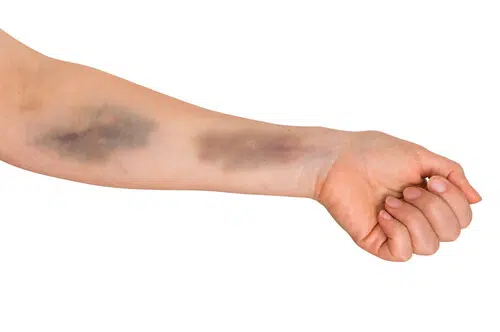
If you are unable to work due to Ehlers Danlos Syndrome (EDS), read our post for how SSA will evaluate your claim for disability benefits.
The Bishop Law Firm has represented disability clients in North Carolina since 2009 and we do not get paid unless we win. Call us today for a free case review, (919) 615-3095 or start your free case review now.
Our firm represents clients in North Carolina only. If you need an attorney outside of NC, please contact NOSSCR (The National Organization of Social Security Claimant's Representatives) for help with attaining disability benefits.
This article is not intended as and does not constitute legal or medical advice on Ehlers Danlos Syndrome. If you have been assessed with or believe you have symptoms of EDS, please seek immediate medical treatment.
Social Security Disability Benefits
Social Security offers two types of disability benefits (in general) for people who are unable to work because of their health, Social Security Disability Insurance (SSDI) and Supplemental Security Income (SSI).
The first step in attaining Social Security Disability benefits is to call your local SSA office or go online to file a claim. If you are unable to work because of your health, you should apply for disability benefits as soon as possible.
However, before you are allowed to file for disability benefits, SSA will determine if you are eligible for Social Security Disability Insurance or Supplemental Security Income.
If you are not eligible, SSA will not allow you to apply, or they may allow you to apply and then send you an automatic denial. Watch our video below for who can apply for Social Security Disability:
What is Ehlers Danlos Syndrome?
Ehlers Danlos Syndrome is an inherited connective tissue disorder that causes overly stretchable joints and fragile skin. Connective tissues are found in almost every organ of the body so EDS' complications can affect far more than skin and joints.
In addition, POTS () and MCAS (Mast Cell Activation Syndrome) are frequently seen with Ehlers Danlos. Marfan Syndrome is also a connective tissue disease.
Types of Ehlers Danlos
There are many types (at least thirteen currently) of Ehlers Danlos but hypermobile Ehlers Danlos syndrome is the most common and vascular Ehlers Danlos syndrome tends to be the most severe. Patients with vascular EDS can suffer from ruptured blood vessels, intestines or uterus (Via Mayo Clinic).
Thin skin, thin nose, thin upper lip, small earlobes and prominent eyes are shared characteristics of those with vascular Ehlers-Danlos. In addition, EDS can be passed from parent to child (genetic disorder) and may cause serious pregnancy complications, so genetic testing is recommended (Mayo Clinic).
In addition to the aesthetic and reproductive symptoms, unstable joints that are prone to frequent dislocation, chronic joint pain, osteoarthritis, poor muscle tone, scoliosis and mitral valve prolapse are some of the symptoms (Via The Ehlers-Danlos Society).
Treatment for EDS depends on the type of EDS you have and the symptoms you experience. A person with EDS may need to see a cardiologist, physical therapist, pain management clinic and psychologist for treatment, to name a few.
Due to poor wound healing, surgical methods of treatment can come with life-threatening complications so treatment options need to be considered carefully (Via NIH).
Unfortunately, people with severe forms of EDS tend to have a shortened life span (median life expectancy of 48 years). However, some with Ehlers Danlos Syndrome can have normal lifespans even if they are restricted in their activities.
Is EDS a disability?
Ehlers Danlos Syndrome can be disabling. With the Social Security Administration, the name of your impairment is not as important as the severity of your symptoms.
Simply being diagnosed with Ehlers Danlos will not qualify you for Social Security Disability or Supplemental Security Income benefits.
Your Ehlers Danlos must cause severe symptoms and treatment side affects that affect your ability to work (engage in substantial gainful activity).
Social Security Disability Benefits for Ehlers Danlos Syndrome
SSA can use the Listing of Impairments, Medical Vocational Guidelines, or combination of your impairments to find you disabled. SSA does not have a listing specifically for Ehlers-Danlos Syndrome but instead uses the listings for the affected body system, (e.g., cardiovascular, visual, musculoskeletal, gastrointestinal).
For example, if your Ehlers Danlos has affected your heart (autonomic dysfunction), you can be evaluated under 4.00 Cardiovascular or your joints, 1.00 Musculoskeletal. You should note that most listings are very difficult to meet. Working has long stopped being an option for those that meet listings.
If you are age 50 and older, the SSA can use the Medical Vocational Guidelines (the Grids) to find you disabled if your Ehlers-Danlos symptoms eliminate your ability to engage in work higher than the sedentary level. But for those under the age of 50, little help is found in the Grids.
Finally, since Ehlers Danlos can affect different body symptoms, you may be found disabled based on the combination of your impairments if you are prevented from working by them.
If you are experiencing extremely thin or fragile skin with bruising to the point that you are unable to touch or be touched, debilitating joint pain with dislocations or severe heart issue from your Ehlers Danlos Syndrome, you may be found disabled by SSA.
Disability Hearings for Ehlers Danlos Syndrome
In my hearings with clients with Ehlers-Danlos, the SSA Administrative Law Judge will want to know the answers to the below questions:
- Do you have pain in your body? Where?
- Is there anything that makes your pain better? Worse?
- How long can you stand? Sit? Walk? How much weight can you lift?
- Do you have any problems with household chores?
- What therapies and medications have you tried for your Ehlers Danlos syndrome?
- Do you have side affects from your medications?
- Have your doctors talked to you about the next step in your treatment plan?
- Have you had any surgeries due to your EDS? Have you healed from surgery? Are you having problems healing?
As discussed above, applying for disability benefits is the first (and most important) step. If you are unable to work because of your Ehlers-Danlos Syndrome apply for disability benefits as soon as possible. Delay may cause you to lose benefits.
The Bishop Law Firm has represented Social Security Disability clients since 2009 in Raleigh, Durham, Fayetteville, Cary, Rocky Mount, Wilson, Smithfield, Louisburg, Chapel Hill, Roanoke Rapids and surrounding areas in North Carolina. Call us today for a free case review, (919) 615-3095 or start online now.

